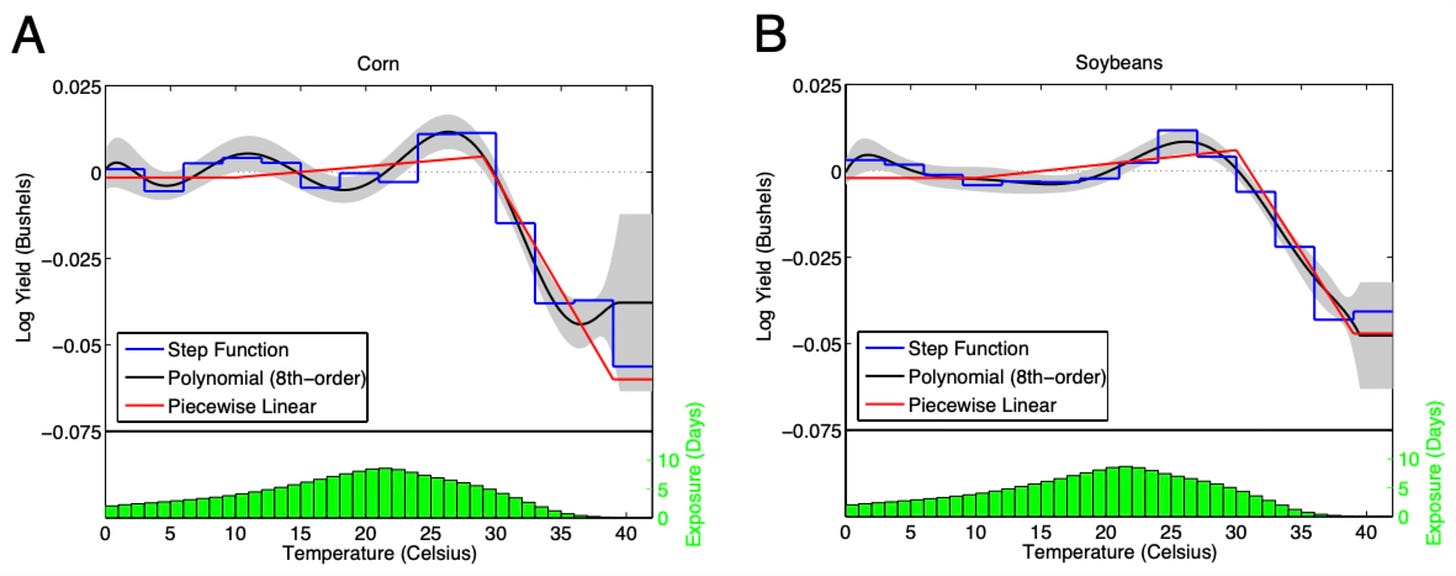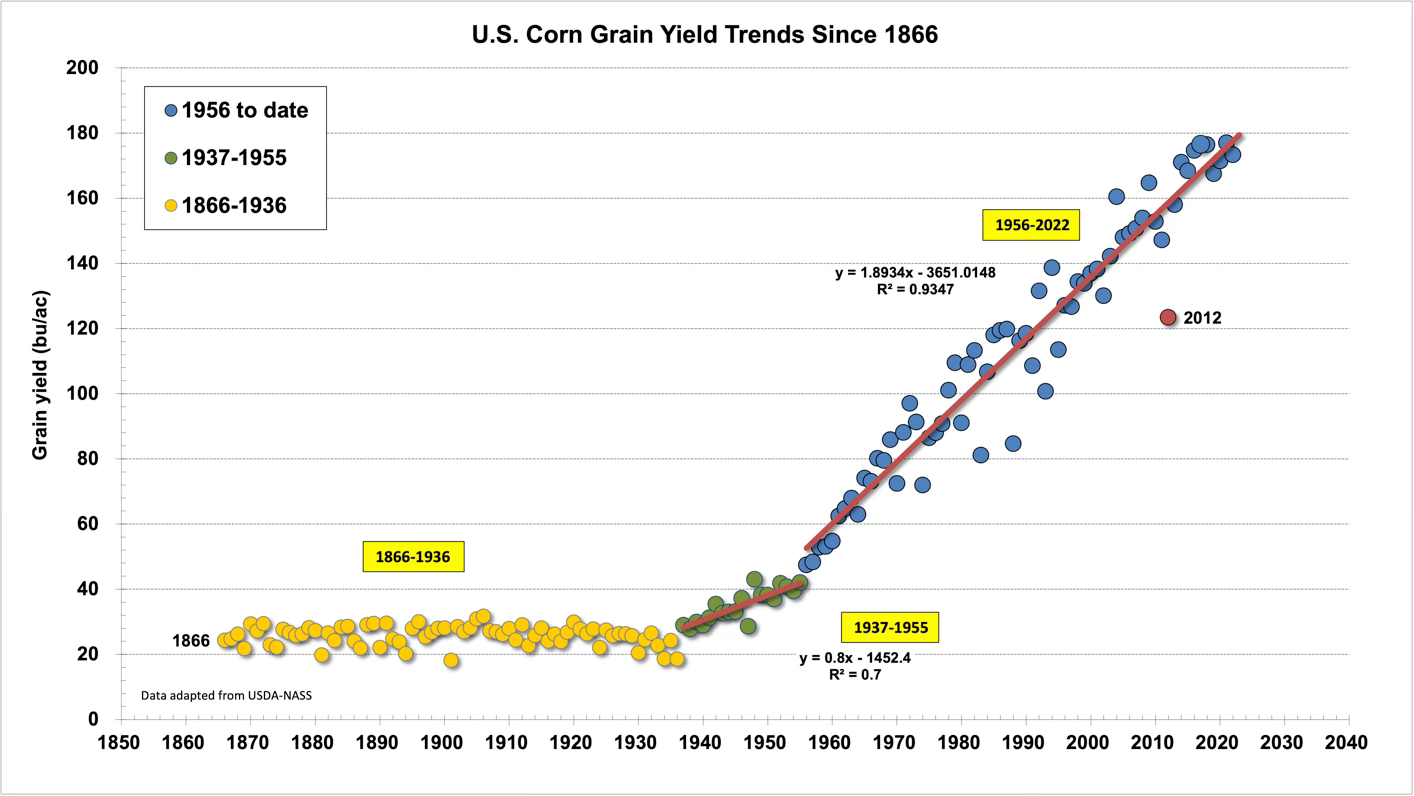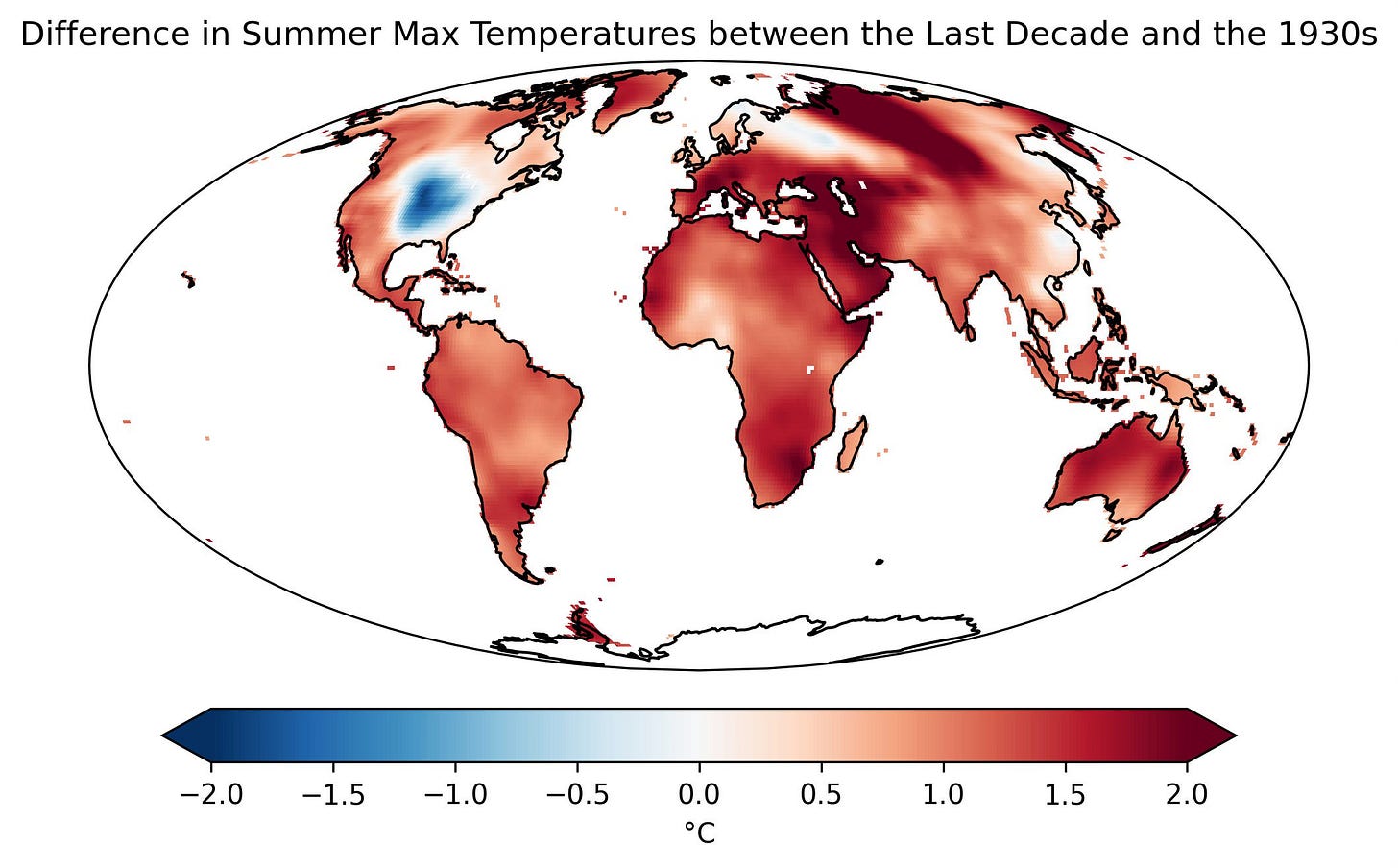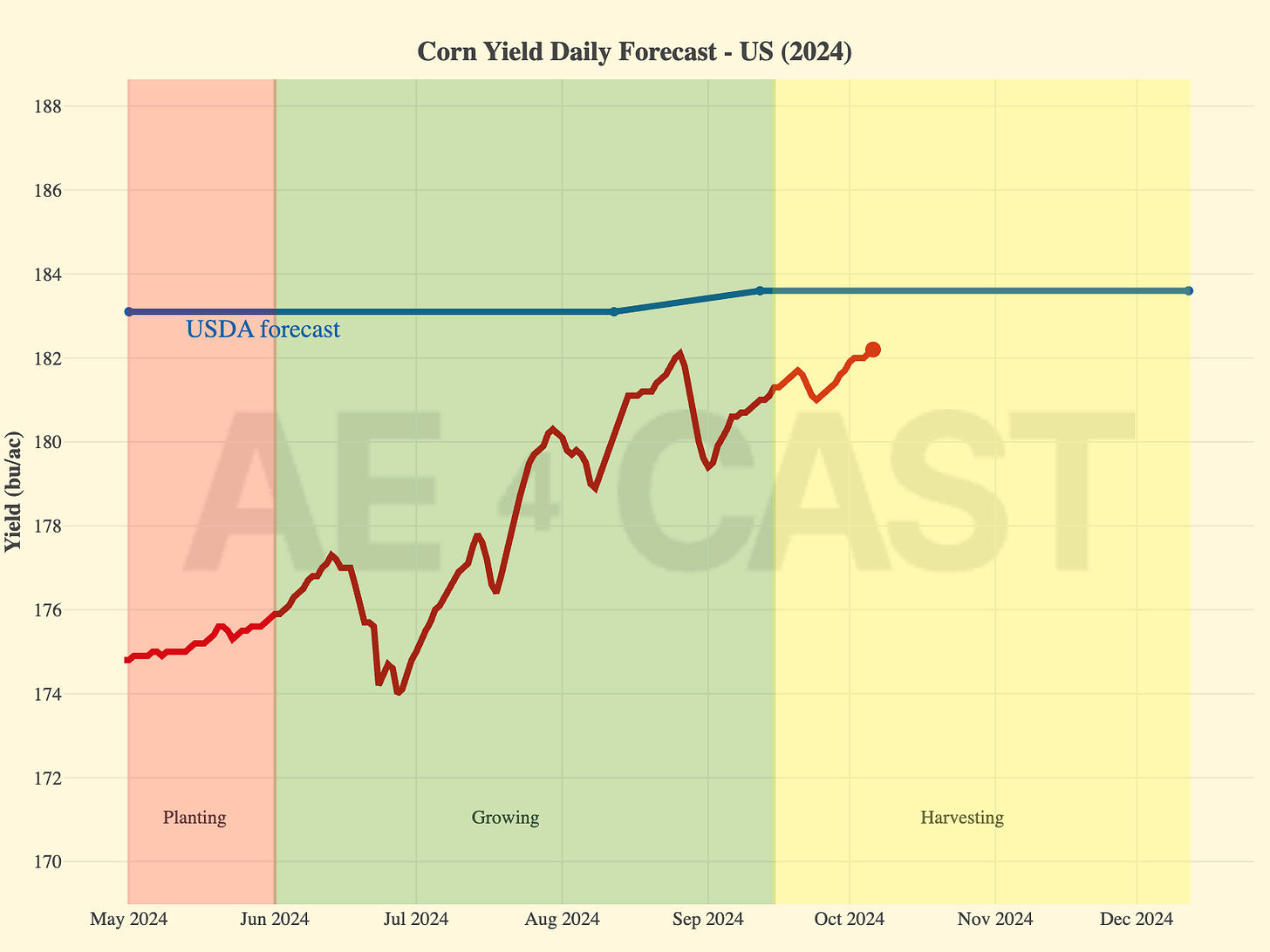Revisiting Crop Sensitivity to Extreme Heat
Fifteen years after documenting sensitivity of corn and soybeans to extreme heat there is no apparent slowdown in yield growth. Why not? Mainly due to a "hole" in global warming.
Old News
In 2009, Wolfram Schlenker and I published a paper in PNAS showing that corn and soybean yields in the United States are very sensitive to extreme heat, and extrapolating that relationship under projected climate changes indicates profoundly negative impacts. Here’s what those relationships look like:
Many others have used regression to link agricultural outcomes to weather. A novelty here was that we accounted for the whole distribution of temperature outcomes and fit a curve to instantaneous temperature in a few different ways. This improves the fit and stability of the relationship: it looks similar across various regions with varying temperature distributions. Most powerfully to my thinking, the pure cross-section (how a county’s typical deviation from the national mean links to its temperature distribution) gives a nearly identical nonlinear relationship as the pure time series (how a year’s temperature anomaly links to the national yield anomaly). These estimates are also similar to panel regression with county fixed effects and whatever kinds of time controls you may like (e.g., state-specific trends or year-fixed effects).
The weather's near-random variation from year to year, the similarity of the different identification strategies, and solid out-of-sample prediction accuracy provide compelling evidence of a causal link and limited adaptation potential.
Many others subsequently used the techniques we used here or similar ones to estimate the impact of climate change on various outcomes. Most of these other studies use only the panel approach. I think these kinds of estimates can be fragile because they are highly nonlinear and heterogeneous, and identification comes from a subtle combination of cross-sectional and time-series variations in weather. This is true even if you’re using fixed effects. (This observation obliquely relates to the new difference-in-difference literature following Sant’Ana and Callaway.) Other factors easily confound cross-sectional identification sources since weather and climate are spatially correlated like everything else. Potential confounding is exacerbated by the highly impactful “extreme” events that tend to be concentrated in certain regions and are relatively rare, so panel regressions are not especially balanced across implicit treatment and control regions. And since both weather and outcomes tend to be spatially correlated, it is easy for scholars to underestimate the size of standard errors.
Wolfram and I were cognizant of these technical issues and bent over backward to consider them. So far, I think the main results hold up reasonably well, although there are some critical emerging caveats that I’ll touch on below. I’m less confident about many other applications of these techniques, however, even though things like mortality, suicide, crime, civil conflict, and GDP growth may draw more interest than corn yields, a point I’ll return to in another post someday.
Any Impacts Yet?
So, we’ve seen a fair amount of global warming since we published that piece. It’s been 15 years since publication, but the sample in the paper ended in 2005, so 19 years of warming have passed, or roughly a 0.4C increase in global temperatures on average. But there has been no apparent slowdown in U.S. yield growth, as you can see in the graph below by Scott Irwin (from a blog post here where he usefully explains that GM crops haven’t boosted crop yields much, if at all). The outlier is 2012, a very hot summer that happened to be a La Niña year.
In the United States, one of the world’s breadbaskets, yield growth has been linear since the 1950s, roughly the time by which most farmers had adopted hybrid corn. The productivity gains have been profound. They have changed the world for the better—feeding the masses while requiring less land and labor—and, for worse, increasing obesity and water quality problems. Aside from the food and environment implications, it is a powerful touchstone for economic scholars who study innovation and technology adoption (see this classic piece by Zvi Griliches).
We have recently seen a slowdown in global agricultural productivity growth, which appears linked to climate change. However, at least so far, there has not been as much of a slowdown in the United States.
Why are there no apparent impacts of warming?
This graph by Andrew Dressler and Zeke Hausfather (copied from this post at The Climate Brink) illustrates the main reason.
The United States and the world have warmed tremendously over the last 90 years, but not, remarkably, during the summer in the Midwestern corn belt — the big blue dot on the map, a “warming hole.” That region has cooled during summer while warming like the rest of the planet during other seasons. That blue dot contains one of the world's highest concentrations of food production. It is very influential for world food commodity prices, comprising nearly 40% of the world’s corn and soybean production. Until recently, it dominated world exports of corn and soybeans, but Brazil now exports more than the US does.
Some of the cooling comes from the fact that the 1930s were extremely hot, the infamous Dust Bowl years. But some also come from the fact that Midwestern summers have cooled over recent decades, a trend Wolfram Schlenker and I noted in this obscure book chapter. Here’s a graph from that paper showing the exposure to extreme heat over time in Indiana. When we wrote this, Indiana had the best station data from the pre-1940 period.
The measure on the vertical axis of this graph, degree days above 29C, captures the downward-sloping portion of the yield-temperature graph above for corn. Against the priors of many, midsummer temperatures in the Corn Belt have been cool, and highly productive.
So, we’ve been lucky. Reduced exposure to extreme heat has been a tailwind for yield growth, not an impediment.
Why has global warming skipped Corn Belt summers?
I don’t think we know.
There are hypotheses. When presenting this research around in the late 2000s and early 2010s, I occasionally received comments from Midwestern scholars that the high concentration of corn and soybeans was acting to cool the Midwest during midsummer. The idea is that massive evapotranspiration from these large and densely seeded crops cools and slightly humidifies the climate, especially during July and August. I cannot find it now, but I think there was one climate modeling group at Iowa State with a downscaled local climate model indicating this. Others tell me they are generally skeptical of local downscaling. There was too much variability across models and too little ability to predict historical climates to place much trust in them. More recently, the Huybers lab at Harvard has been making similar arguments [1, 2], but I find the evidence vague and correlative. It seems more likely, however, that land degradation contributed to the soaring heat and drought of the 1930s. A number of studies investigate this; here’s one. An extreme La Niña has been blamed as the primary factor, however. Interestingly, the worst Midwestern drought in recent memory, 2012, was also a La Niña year.
A couple of years ago, an exceptional undergraduate student here at UH, Eleanor Yuan, a double major in Economics and Global Environmental Science, wrote an honors thesis under my direction that took a more fine-grained look at the link between temperatures and corn and soybean planting densities, to see if these crops were taking the edge off of extreme temperatures during the peak evapotranspiration periods of the growing season. The upshot of this work suggests pretty strongly that the corn isn’t cooling the climate, or if it is, it’s via a much larger and more complex interaction between crops and weather than I can contemplate. (Aside: This was fantastic work, especially for an undergraduate. I really hope she publishes this and decides to go to grad school one day—she’d be a catch.)
Anyhow, I remain skeptical of the “corn cooling the climate” hypothesis, but land use has likely interacted with climate in some ways.
Last couple of years
Global temperatures have risen sharply in the last couple of years. The excellent Climate Brink recurrently focuses on this. The recent rapid warming appears to be a combination of factors, including El Niño, climate change, and probably other obscure cyclical factors beyond me and seemingly to actual climate scientists. Here’s another graph lifted from Climate Brink:
Interestingly, and in surprising contrast, these years have been remarkably cool in the Corn Belt summers. The graph below shows the corn-area-weighted average accumulation of extreme heat (degree days above 29C) for all crop years since 1971, with the last two years highlighted (red is 2024, orange is 2023. This is a national average, but weights the Corn Belt very heavily. The next plot shows cumulative precipitation. As you can see, the weather hasn’t been extreme.
These graphs come from a fledgling startup that I’ve begun with Sisi Zhang, a former grad student, to forecast crop yields in real time over the growing season.
Here are our projected corn yields for these two years.
We nailed the national USDA yield last year, but this wasn’t clear until a late revision by USDA, but we had some sizable errors in some states. We’re still a couple months away from the final verdict on this year’s crop, but it’s almost sure to be a record.
Our underlying model is a bit more complex than anything I’ve published. The daily forecasts also require a daily forecast of future weather, which is complicated by the fact that weather enters the model nonlinearly and forecasts have a high degree of uncertainty—it was a lot of work to develop methods with consistent estimates. We plan to expand to more countries and have lots of plans for model refinements if we find the time and resources to do it. You can learn more about it at AE4cast.com. I’ve made a few posts about forecasts on LinkedIn.
Prospects for the Future
So, given all of this, what should we expect going forward? Many questions remain about projected warming in the Corn Belt and other key crop regions and whether historical links between extreme temperatures and yields can be extrapolated to future climates. I think our 2009 study shows that there are huge risks, but I appreciate that these simple extrapolations to the future are prone to multiple sources of error. See, for example, this recent paper by Jonathan Proctor and coauthors (in the ever-optimistic Huybers’ lab). But I think most of the uncertainties here have to do with complexities of crop growth and climate and less to do with economists’ obsession with “adaptation,” usually defined as farmer adjustments in crops and practices in response to warmer climates, holding all else the same. I see this aspect as a small 2nd order effect. I’ll write more about some of this and other ambiguities in future posts. I’ll also write about other approaches to crop modeling, including methods favored by crop scientists, and the possible mechanisms underlying the extreme heat link and how and why it might not be stable over time and space.
To me, the future looks highly uncertain and possibly stark. There is undoubtedly a possibility that we’ll see decades of extremes like the 1930s or worse in the not-too-distant future, and that such extremes could devastate crop production in the US and lead to a global food crisis. That might be hard to see with a record crop about to be harvested, high inventories, and falling grain and oilseed prices. It’s also conceivable to me that climate change won’t be so bad, but other factors could slow productivity growth. Finally, it’s possible that the luck may continue or even accelerate, with AI-driven tractors and drones creating a new precision agriculture that grows productivity to heights we’ve never dreamt of, reducing land use requirements and nutrient runoff, growing soil carbon, and reducing climate change to a minimal concern.
All these things are possible.
But uncertainty is not our friend. The downside risks are significant enough in my view to warrant rapid decarbonization, which has become another focus of my research.
Thanks for reading. Comments welcome. If you liked this, please share and spread the word and I’ll be motivated to write more.
Update: New Evidence on the Effects of Afforestation
A colleague wrote to remind me of a new working paper by Florian Grosset-Touba, Anna Papp, and Charles Taylor that examines how a large-scale forestation program, The Great Shelterbelt, caused a significant increase in rainfall and reduced temperatures in the decades following the Dust Bowl, impacting corn production markedly. I suspect this is at least half the story. Many others have written about how land degradation contributed to the extreme heat during the Dust Bowl years, and this forestation program undoubtedly contributed to reversing some of that degradation. The paper uses a simple yet compelling identification strategy, comparing areas more and less treated with afforestation activities to show climate and agricultural sector changes. This is clear, exciting work.
I still think it’s interesting that extreme heat hasn’t been rising in the Corn Belt in recent decades, and I wonder (and worry) what the odds are that this fortunate weather will change for the worse the next time we have a super La Niña.












I'm not an atmospheric scientist but I have heard that the central corn belt has mostly stable rainfall totals each year due to two fairly independent sources of moisture. One is the jet stream that goes west to east across the continent, bringing moisture. The second is moisture coming up as remnants of hurricanes and tropical storms that originate in the Gulf of Mexico.
Great post, glad to see you are restarting your blogging g efforts